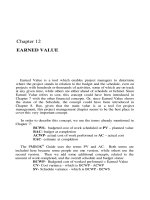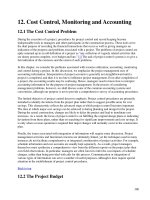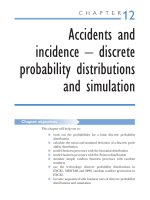ila1666681724 sadsdsds ádasda
Bạn đang xem bản rút gọn của tài liệu. Xem và tải ngay bản đầy đủ của tài liệu tại đây (5.07 MB, 39 trang )
3/4/2022
CHAPTER 12
Abstract Data Type
q Define the concept of an abstract data type (ADT).
q Define a stack, the basic operations on stacks, their applications, and how
they can be implemented.
q Define a queue, the basic operations on queues, their applications, and how
they can be implemented.
q Define a general tree and its application.
q Define a general linear list, the basic operations on lists, their application
and how they can be implemented.
q Define a binary tree—a special kind of tree—and its applications.
q Define a binary search tree (BST) and its applications.
q Define a graph and its applications.
1
3/4/2022
12.1.1 Simple ADTs
Many programming languages already define some simple
ADTs as integral parts of the language. For example, the C
language defines a simple ADT called an integer. The type of
this ADT is integer with predefined ranges. C also defines
several operation that can be applied on this data type
(addition, subtraction, multiplication, division, and so on). C
explicitly defines these operations on integers and what we
expect as the results. A programmer who writes a C program
to add two integers should know about the integer ADT and
the operations that can be applied to it.
2
3/4/2022
12.1.2 Complex ADTs
Although several simple ADTs, such as integer, real,
character, pointer, and so on, have been implemented and are
available for use in most language, many useful complex
ADTs are not. As we will see in this chapter, we need a list
ADT, a stack ADT, a queue ADT, and so on. To be efficient,
these ADTs should be created and stored in the library of the
computer to be used.
The concept of abstraction means:
1. We know what a data type can do.
2. How it is done is hidden.
12.1.3 Definition
Let us now define an ADT. An abstract data type is a data
type packaged with the operations that are meaningful for
the data type. We then encapsulate the data and the
operations on the data and hide them from the user.
Abstract data type:
1. Definition of data
2. Definition of operations
3. Encapsulation of data and operation
3
3/4/2022
12.1.4 Model for an abstract data type
The ADT model is shown in Figure 12.1. Inside the ADT are
two different parts of the model: data structure and
operations (public and private).
Figure 12.1 The model for an ADT
12.1.5 Implementation
Computer languages do not provide complex ADT packages.
To create a complex ADT, it is first implemented and kept in
a library. The main purpose of this chapter is to introduce
some common user-defined ADTs and their applications.
However, we also give a brief discussion of each ADT
implementation for the interested reader. We leave the
pseudocode algorithms of the implementations as
challenging exercises.
4
3/4/2022
Figure 12.2 Three representations of stacks
12.2.1 Operations on stacks
There are four basic operations, stack, push, pop, and empty,
that we define in this chapter.
The stack operation
The stack operation creates an empty stack. The following
shows the format.
Figure 12.3 Stack operation
5
3/4/2022
The push operation
The push operation inserts an item at the top of the stack.
The following shows the format.
Figure 12.4 Push operation
The pop operation
The pop operation deletes the item at the top of the stack.
The following shows the format.
Figure 12.5 Pop operation
6
3/4/2022
The empty operation
The empty operation checks the status of the stack. The
following shows the format.
This operation returns true if the stack is empty and false if
the stack is not empty.
12.2.2 Stack ADT
We define a stack as an ADT as shown below:
7
3/4/2022
Example 12.1
Figure 12.6 Example 12.1
12.2.3 Stack applications
Stack applications can be classified into four broad
categories: reversing data, pairing data, postponing data
usage, and backtracking steps. We discuss the first two in
the sections that follow.
Reversing data items
Reversing data items requires that a given set of data items
be reordered so that the first and last items are exchanged,
with all of the positions between the first and last being
relatively exchanged also. For example, the list (2, 4, 7, 1, 6,
8) becomes (8, 6, 1, 7, 4, 2).
8
3/4/2022
Example 12.2
9
3/4/2022
Pairing data items
We often need to pair some characters in an expression. For
example, when we write a mathematical expression in a
computer language, we often need to use parentheses to
change the precedence of operators. The following two
expressions are evaluated differently because of the
parentheses in the second expression:
When we type an expression with a lot of parentheses, we
often forget to pair the parentheses. One of the duties of a
compiler is to do the checking for us. The compiler uses a
stack to check that all opening parentheses are paired with a
closing parentheses.
10
3/4/2022
Example 12.3
11
3/4/2022
12.2.4 Stack implementation
At the ADT level, we use the stack and its four operations; at
the implementation level, we need to choose a data structure
to implement it. Stack ADTs can be implemented using
either an array or a linked list. Figure 12.7 shows an example
of a stack ADT with five items. The figure also shows how
we can implement the stack.
In our array implementation, we have a record that has
two fields. The first field can be used to store information
about the array. The linked list implementation is similar: we
have an extra node that has the name of the stack. This node
also has two fields: a counter and a pointer that points to the
top element.
Figure 12.7 Stack implementations
12
3/4/2022
Figure 12.8 Two representation of queues
12.3.1 Operations on queues
Although we can define many operations for a queue, four
are basic: queue, enqueue, dequeue, and empty, as defined
below.
The queue operation
The queue operation creates an empty queue. The following
shows the format.
Figure 12.9 The queue operation
13
3/4/2022
The enqueue operation
The enqueue operation inserts an item at the rear of the
queue. The following
shows the format.
Figure 12.10 The enqueue operation
The dequeue operation
The dequeue operation deletes the item at the front of the
queue. The following shows the format.
Figure 12.11 The dequeue operation
14
3/4/2022
The empty operation
The empty operation checks the status of the queue. The
following shows the format.
This operation returns true if the queue is empty and false if
the queue is not empty.
12.3.2 Queue ADT
We define a queue as an ADT as shown below:
15
3/4/2022
Example 12.4
Figure 12.12 Example 12.4
12.3.3 Queue applications
Queues are one of the most common of all data processing
structures. They are found in virtually every operating
system and network and in countless other areas. For
example, queues are used in online business applications
such as processing customer requests, jobs, and orders. In a
computer system, a queue is needed to process jobs and for
system services such as print spools.
12.32
16
3/4/2022
Example 12.5
17
3/4/2022
Example 12.6
18
3/4/2022
12.3.4 Queue implementation
At the ADT level, we use the queue and its four operations at
the implementation level, we need to choose a data structure
to implement it. A queue ADT can be implemented using
either an array or a linked list. Figure 12.13 on page 329
shows an example of a queue ADT with five items. The
figure also shows how we can implement it. In the array
implementation we have a record with three fields. The first
field can be used to store information about the queue.
The linked list implementation is similar: we have an
extra node that has the name of the queue. This node also has
three fields: a count, a pointer that points to the front
element, and a pointer that points to the rear element.
Figure 12.13 Queue implementation
19
3/4/2022
Figure 12.14 General linear list
12.4.1 Operations on general linear lists
Although we can define many operations on a general linear
list, we discuss only six common operations in this chapter:
list, insert, delete, retrieve, traverse, and empty.
The list operation
The list operation creates an empty list. The following shows
the format:
20
3/4/2022
The insert operation
Since we assume that data in a general linear list is sorted,
insertion must be done in such a way that the ordering of the
elements is maintained. To determine where the element is to
be placed, searching is needed. However, searching is done
at the implementation level, not at the ADT level.
Figure 12.15 The insert operation
The delete operation
Deletion from a general list (Figure 12.16) also requires that
the list be searched to locate the data to be deleted. After the
location of the data is found, deletion can be done. The
following shows the format:
Figure 12.16 The delete operation
21
3/4/2022
The retrieve operation
By retrieval, we mean access of a single element. Like
insertion and deletion, the general list should be first
searched, and if the data is found, it can be retrieved. The
format of the retrieve operation is:
Figure 12.17 The retrieve operation
The traverse operation
Each of the previous operations involves a single element in
the list, randomly accessing the list. List traversal, on the
other hand, involves sequential access. It is an operation in
which all elements in the list are processed one by one. The
following shows the format:
The empty operation
The empty operation checks the status of the list. The
following shows the format:
22
3/4/2022
The empty operation
The empty operation checks the status of the list. The
following shows the format:
This operation returns true if the list is empty, or false if the
list is not empty.
12.4.2 General linear list ADT
We define a general linear list as an ADT as shown below:
23
3/4/2022
Example 12.7
Figure 12. 18 Example 12.7
12.4.3 General linear list applications
General linear lists are used in situations in which the
elements are accessed randomly or sequentially. For
example, in a college a linear list can be used to store
information about students who are enrolled in each
semester.
24
3/4/2022
Example 12.8
25









